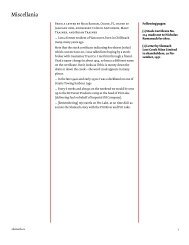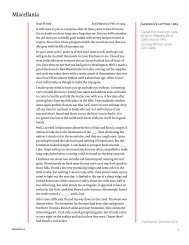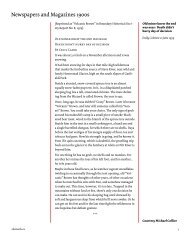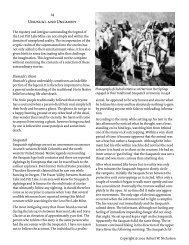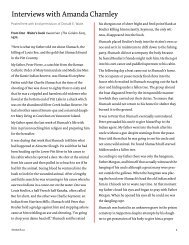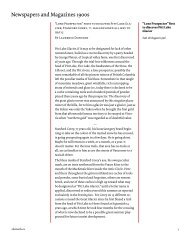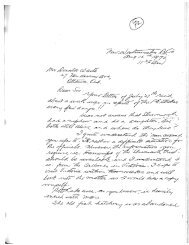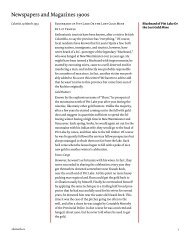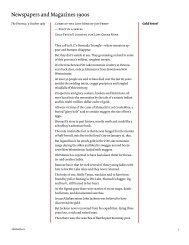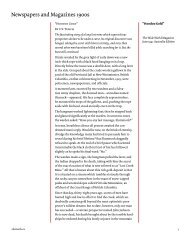3 Jackson (d. – Ca. 1906 ) - Slumach
3 Jackson (d. – Ca. 1906 ) - Slumach
3 Jackson (d. – Ca. 1906 ) - Slumach
Create successful ePaper yourself
Turn your PDF publications into a flip-book with our unique Google optimized e-Paper software.
this natural rock structure. This itself is undeniably a<br />
tent shaped rock without comparison.<br />
I am fairly confident that this rock formation is the<br />
tent shaped rock that <strong>Jackson</strong> was referring to simply<br />
because of the hundreds of tent shaped rocks in<br />
the search area this is the only one that is definitely<br />
unique, can not be missed, and is within the travel<br />
distance identified in his letter. And, these are the only<br />
two rocks on the entire bench.<br />
No marks have been located or identified on either the<br />
“<strong>Jackson</strong> rock” or the tent shaped slabs. However, the<br />
inside of the slabs unfortunately were not examined.<br />
<strong>Jackson</strong> literally wrote that there was a mark cut out<br />
“in” the rock not “on” the rock. It has been suggested<br />
that the mark may actually be on the inside of the slabs.<br />
Only a re-examination of the site can determine if <strong>Jackson</strong><br />
literally meant “in” or “on” the rock.<br />
I have been independently advised that the ashes from<br />
the fire pits were carbon dated a few years ago. The<br />
carbon dating results identified the ashes as being circa<br />
very early 1800s.<br />
The location of this site combined with he carbon dating<br />
results and Duff ’s documentation, discussed in the<br />
previous chapter, are strong indicators that this location<br />
is not only of interest to the <strong>Jackson</strong> portion of the<br />
Pitt Lake Legend it, may also be of significant historical<br />
value related to Native culture and history.<br />
The Archaeology department at The University of British<br />
Columbia was unaware of this site when I contacted<br />
them. Subsequent consultation with an independent<br />
archaeologist has proven to be most interesting and<br />
enlightening.<br />
Without physically examining this site, the archaeological<br />
consultant is confident that the location may<br />
actually be an undocumented site of an ancient Native<br />
seasonal hunting camp. This opinion is based on several<br />
factors of which two principle ones are notable for<br />
the subject of this writing.<br />
Firstly, the semi-circle of old fire pits are strong indicators<br />
that the pits were used by Native hunting parties<br />
for drying meat hung over the boulder. Native hunting<br />
parties commonly dried their meat at the site of their<br />
seasonal hunting camps because they were able to pack<br />
out far greater quantities of dried meat than fresh meat<br />
to the main encampment or settlement.<br />
Secondly, the preferred meat of the Natives identified<br />
as having traditional access to the area was black bear,<br />
closely followed by mountain-goat. The location is<br />
almost in the center of an area still well known for both<br />
species. The location is not far off of the Iceworm Creek<br />
trail that leads from Glacier Lake to the Pitt River.<br />
As a general point of interest, the archaeologist has<br />
additionally expressed an interest in the possible association<br />
of this site to the Native tribe identified as the<br />
Squalls by Duff in the previous chapter.<br />
The archaeologist’s professional opinion, even without<br />
physical assessment of the sight, does, in itself, offer<br />
an interesting correlation to the fact that <strong>Slumach</strong> met<br />
a Port Douglas Native hunting party and <strong>Jackson</strong> tells<br />
his friend to take trustworthy Natives and only tell<br />
people he is going on a hunting trip. As a final reference<br />
to <strong>Jackson</strong>’s letter it is curious to note that he did not<br />
identify any lake by name and simply referred to the<br />
location of the creek as being two or three days from<br />
“the lake.”<br />
The only reference that I can find that places <strong>Jackson</strong><br />
at Pitt Lake is found in a story which again features<br />
<strong>Slumach</strong>’s nephew, Peter Pierre. Peter Pierre claimed<br />
to have found <strong>Jackson</strong> on the eastern shore of Pitt Lake<br />
across from Little Goose Island in 1903. <strong>Jackson</strong> was<br />
physically exhausted and extremely sick. He claimed<br />
to have been helped to the lake shore by and old Native<br />
women. As Pierre paddled the canoe down the<br />
Lake, <strong>Jackson</strong> told him about dense fogs, impenetrable<br />
underbrush, unbelievable “Devils club” and other hardships<br />
he had endured.<br />
On the trip down the Lake <strong>Jackson</strong> also made reference<br />
to hot springs. There are two known locations of hot<br />
spring in the general search area. One is located on the<br />
west side of the upper Pitt River, north of Alvin, a short<br />
distance upstream from where the main logging road<br />
bridge crosses the river. The second is located at the<br />
junction of the North and South Sloquet Creeks. There<br />
is also rumored to be a third hot spring located somewhere<br />
in the Iceworm Creek area. This third hot spring,<br />
being located in the same area as what I have referred to<br />
as the “<strong>Jackson</strong> rock” does prove uniquely interesting.<br />
During the time period in which <strong>Jackson</strong> was undoubtedly<br />
involved in his adventures there was an extensive<br />
prospecting frenzy taking place in the upper Harrison<br />
Lake area, specifically in the vicinity of Fire Mountain.<br />
In addition to the mineral finds in the Harrison Lake<br />
area, Port Douglas at the north end of Harrison Lake<br />
had been the prospectors’ gateway to the northern gold<br />
fields. The entire area had been and was once again<br />
Copyright © 2002 Robert W. Nicholson



